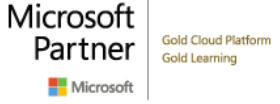Description
- Date: March 01- 05, 2021 | 8:30 AM – 4:30 PM EST -12 Seats Left Register Early to secure class
- Date: March 08- 12, 2021 | 8:00 AM – 4:00 PM PST -15 Seats Left Register Early to secure class
- Date: March 15 – 19, 2021 | 11:30 AM – 7:30 PM EST -15 Seats Left Register Early to secure class
- Date: April 12 – 16, 2021 |8:30 AM – 4:30 PM EST -15 Seats Left Register Early to secure class.
These class dates will give a $400.00 Discount for registrations completed before 01/22/2021.
- Delivery Format: Virtual Classroom Live
- Location: ONLINE
Dates are not a fit? Ask about Private Lead Classes for your company team, with 6 or more employees.
Classroom Live Online Outline
Module 1: Deploying Exchange Server This module explains the key features and architecture of Exchange Server. It also explains the prerequisites and requirements for deploying Exchange Server. Additionally, it explains how to use the Exchange admin center and the Exchange management shell to manage Exchange Server. Lessons
- Overview of Exchange Server
- Exchange Server architecture
- Requirements for Exchange Server
- Deploying Exchange Server Exchange Server
- Exchange Server Management Tools
- Describe the key features and functionality of Exchange Server.
- Describe the Exchange Server architecture.
- Describe the requirements and options for deploying Exchange Server.
- Deploy Exchange Server.
- Describe how to use management tools to manage Exchange Server.
- Exchange Server mailbox databases
- Exchange Server storage
- Configuring Exchange Server mailbox databases and storage
- Describe the features of Exchange Server mailbox databases.
- Explain the storage options available for Exchange Server.
- Configure Exchange Server mailbox databases and storage.
- Managing user mailboxes
- Managing other types of mailboxes
- Managing other recipients objects
- Configuring policies and address lists
- Manage user mailboxes in Exchange Server.
- Manage shared, resource, public folder, and arbitration mailboxes in Exchange Server.
- Manage contacts, mail users, and distribution groups in Exchange Server.
- Configure address lists, and email address and address book policies in Exchange Server.
- Overview of the Exchange Management Shell
- Managing Exchange Servers by using Exchange Management Shell cmdlets
- Managing Exchange servers by using scripts
- Manage recipients by using Exchange Server cmdlets.
- Manage Exchange servers by using Exchange Server cmdlets.
- Manage Exchange servers by using scripts.
- Configuring client access services
- Managing client access services
- Client connectivity in Exchange Server
- Configuring Outlook on the web
- Configuring mobile messaging
- Configure client access services in Exchange Server.
- Manage client access services.
- Describe client connectivity and publishing of Exchange Server services.
- Configure Outlook on the web.
- Configure mobile messaging on Exchange Server.
- High availability on Exchange Server
- Configuring highly available mailbox databases
- Configuring high availability of Client Access services
- Describe the high availability in Exchange Server.
- Configure highly available mailbox databases.
- Configure high available Client Access services.
- Implementing Exchange Server backup
- Implementing Exchange Server recovery
- Back up Exchange Server data.
- Restore Exchange Server data by using the configured backups.
- Overview of message transport
- Configuring message transport
- Managing transport rules
- Describe messaging transport in Exchange Server.
- Configure message transport in Exchange Server.
- Manage transport rules in Exchange Server.
- Deploying and managing an Edge Transport server for message security
- Implementing an antivirus solution for Exchange Server
- Implementing an antispam solution for Exchange Server
- Deploy and manage an Edge Transport server for message security.
- Implement an antivirus solution for Exchange Server.
- Implement an antispam solution for Exchange Server.
- Monitoring Exchange Server
- Troubleshooting Exchange Server
- Configure performance monitoring in Exchange Server.
- Troubleshoot issues in Exchange Server.
- Securing Exchange Server by using RBAC
- Configuring audit logging in Exchange Server
- Maintaining Exchange Server
- Secure Exchange Server by using RBAC.
- Configure audit logging in Exchange Server.
- Maintain and update Exchange Server.
- Overview of Exchange Online and Office 365
- Managing Exchange Online
- Implementing the migration to Exchange Online
- Managing a hybrid environment
- Provide an overview of Exchange Online and Office 365.
- Manage Exchange Online.
- Implement a migration to Exchange Online
Classroom Live Labs
Lab : Deploying Exchange Server
- Evaluating requirements and prerequisites for an Exchange Server 2019 installation
- Deploying Exchange Server 2019
- Verifying Exchange Server functionality
- Installing Exchange Server 2019 on Windows Server Core 2019 (optional)
- Creating and configuring mailbox databases
- Configuring recipient objects
- Managing public folder mailboxes
- Managing email address policies
- Managing address lists and address book policies
- Using Exchange Management Shell to manage recipients
- Using Exchange Management Shell to manage Exchange Server
- Configuring namespaces for client access
- Configuring certificates for client access
- Configuring custom MailTips
- Configuring Exchange Server for Outlook
- Configuring Outlook on the web
- Configuring Microsoft Exchange ActiveSync
- Creating and configuring a DAG
- Deploying a high availability solution for Client Access services
- Testing the high availability configuration
- Backing up an Exchange Server mailbox database
- Restoring Exchange Server mailbox
- Restoring a database availability group (DAG) member (optional)
- Configuring message transport
- Monitoring and verifying message delivery
- Configuring a disclaimer transport rule
- Configuring a DLP policy for financial data
- Configuring and testing EdgeSync
- Configuring antivirus, antispam and malware protection features
- Monitoring Exchange Server
- Troubleshooting database availability
- Troubleshooting Client Access servers
- Configuring Exchange Server permissions
- Configuring audit logging
- Maintaining Exchange Server
- Managing Exchange Online





